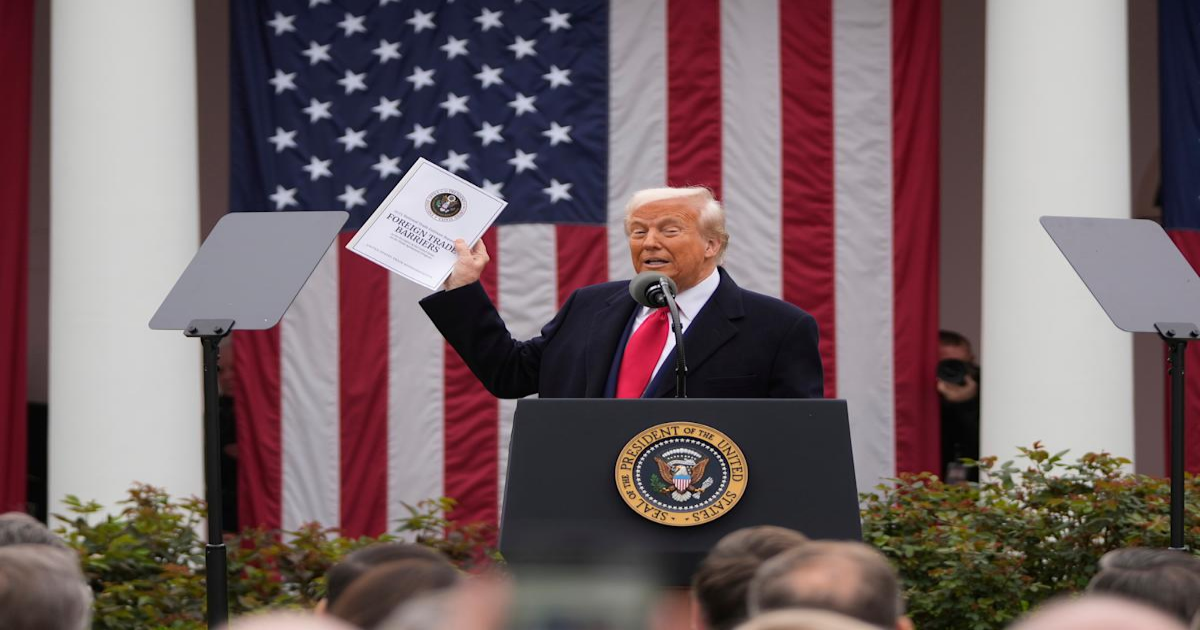“Liberation Day” turned out to be alarming. President Trump floored investors by announcing the largest tax hike on Americans since at least the 1940s.
April 2, which Trump called “Liberation Day,” was Trump’s deadline for unveiling a sweeping set of taxes on imports that almost nobody in the investing universe saw coming. For the first two months of his presidency, Trump had threatened tariffs, imposed some, delayed others, and generally left market watchers hoping his bark would be worse than his bite.
His bite turned out worse than his bark. The April 2 announcements included two sets of import tariffs. One is a new “universal” tax on imports from everywhere. The average tariff rate on imports at the start of the year was about 2.5%. So the 10% universal tariff on its own would raise the average tariff to 12.5%. That would be the highest since around 1940.
Read more: What Trump’s tariffs mean for the economy and your wallet
Much beefier are “reciprocal” tariffs that are supposed to punish US trade partners that impose tougher barriers on imports from the United States than vice versa. To come up with those figures, Trump measured not just the taxes other nations impose on US imports but 14 categories of “nonmonetary” actions that Trump says keep American products out of foreign markets. That led to the eye-popping “reciprocal” taxes Trump now plans to impose on products from dozens of countries.
The current average tariff on imports from China, for instance, is about 3%. Trump wants to raise that to 34%. For Japanese imports, the tax will rise from 1.6% to 24%. For products from Europe, the tax will rise from the 2% range to 20%. The universal 10% tariff is scheduled to start on April 5, while the reciprocal tariffs are set to go into effect April 9. Unlike any change to income taxes or most other taxes, which require congressional legislation, Trump can impose tariffs on his own authority.
Some of the Trump taxes are “stacked,” which means that multiple new tariffs might apply to some products. The matrix of overlapping new taxes compounds the confusion businesses already have to deal with as they try to understand what costs are likely to rise and by how much.
Americans bought about $3.3 trillion worth of imports in 2024. The tariff rate of about 2.5% yielded a tariff tax bill of about $83 billion. Investing firm Evercore estimates that all the new tariffs combined will push the tax rate on imports to about 29%. If import purchases stayed the same, that would raise the tariff bill to about $960 billion, making it an $880 billion tax hike paid by American businesses and consumers.
“It’s the biggest tax hike on Americans since the 1940s,” trade expert Inu Manak of the Council on Foreign Relations told Yahoo Finance on March 2. “The only thing these tariffs are going to do is increase costs.”
Economists are now busy trying to figure out whether the shock to corporate profits, stock values, and consumer wallets will be enough to cause a recession. Imports are only about one-tenth of total US GDP, which is nearly $30 trillion. So, as sweeping as the Trump tariffs are, they won’t affect everything in the US economy.
President Donald Trump speaks during an event to announce new tariffs in the Rose Garden at the White House, Wednesday, April 2, 2025, in Washington. (AP Photo/Mark Schiefelbein) · ASSOCIATED PRESS
Drop Rick Newman a note, follow him on Bluesky, or sign up for his newsletter.
They will have major knock-on effects, though. When imported products get more expensive, it allows manufacturers of competing domestic products to raise prices too. It’s also a near certainty that trade partners will retaliate against Trump’s tariffs with their own punitive measures on US exports, which will dent revenue and profits for US exports and further hurt growth.
Economists have already been lowering their forecasts for economic growth and raising their inflation estimates on account of Trump tariffs. Shortly before Trump’s badly misnamed “Liberation Day,” Goldman Sachs raised its odds of a US recession within 12 months from 20% to 25%. The risk of recession is certainly higher now.
Read more: The latest news and updates on Trump’s tariffs
“US growth is now headed for stall speed, and maybe worse than that,” Brett Ryan, senior US economist at Deutsche Bank, told Yahoo Finance on April 2. “If not an outright recession, this certainly raises the risk of one.”
If there’s any solace for investors, it’s that Trump can put the lightning back in the bottle just as fast as he unleashed it. Some trade partners may make concessions that lead to lower tariff rates. There are also likely to be thousands of case-by-case exemptions in which the Trump administration waives tariffs for companies facing particular hardships.
Trump claims that high taxes on imports will lead to more domestic manufacturing and a revival of US manufacturing. In the best case, however, that will take years and generate uncertain results. The worst case may be what investors are facing now.
Rick Newman is a senior columnist for Yahoo Finance. Follow him on Bluesky and X: @rickjnewman.
Read the latest financial and business news from Yahoo Finance
